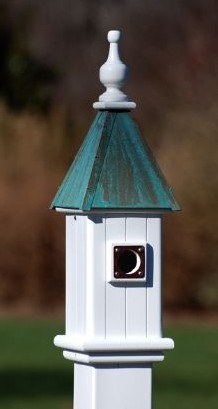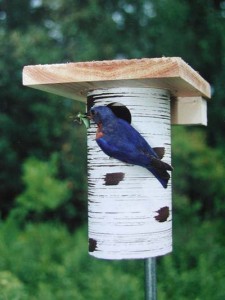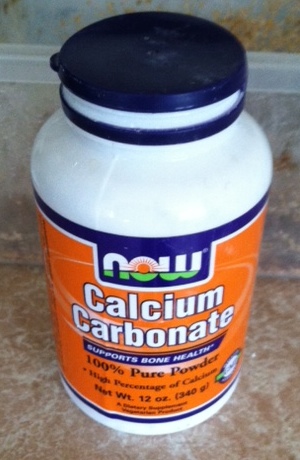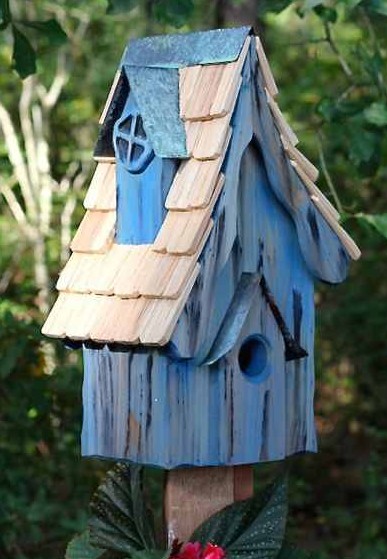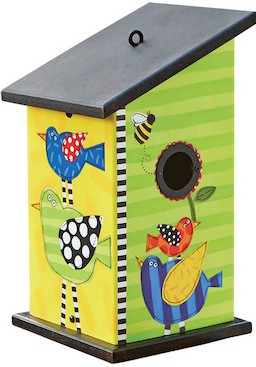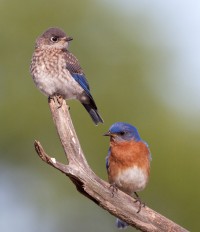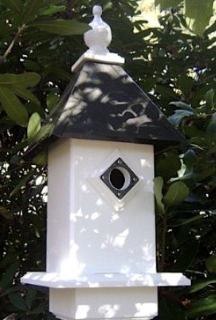-
Vinyl Bluebird Houses that Rock and Secret Sauce for Blues!
‘Tis the season, bluebirds are busy claiming territory, finding mates and already nesting in many parts of the country. Because they typically have 2-3 broods per season, it’s not too late to entice them to your place with quality bluebird houses.
Open spaces best suit blues, with places to perch and swoop up insects. They’ll perch on lower limbs of nearby trees, on top of birdhouses, and even on feeder poles. Not only to hunt prey, but to keep a watchful eye over their box and nestlings as well. They’re such tentative parents, with mom & dad’s teamwork accounting for successful fledges!
Vinyl bluebird houses rock because they’ll never deteriorate like wood. The light color is better for late summer scorching temperatures too. This copper roof bluebird house is complete with predator guard and removable roof for easy nest clean-out. It mounts on a standard 4×4 post… no tools required!
The Gilbertson nest Box is also mighty popular among blues. Vinyl with a birch appearance, it’s a great design if you’re up for monitoring nests (recommended). Be polite and always knock first (well, tap) before checking nests!
The secret sauce? In an attempt to bring bluebirds to our yards, and after exhausting all other food treats to lure them, many folks finally resort to offering live mealworms. They do the trick! But what soon happens with many bird addicts (like any addiction) is we’re feeding too many worms and the bird’s diet is skewed.
Extremely high in protein, too many worms can cause problems for female blues during nesting season. Something called egg bound, where she becomes unable to pass/lay her egg. It’s fatal most times, and really sad when seasoned bluebird monitors discover this. It can and does happen in the wild without gorging on meal worms too.
So if you’ve got the bluebird itch and find yourself feeding lots of worms during nesting season, this supplement helps lower the chance of females becoming egg-bound. Calcium carbonate powder is widely available online, or maybe at your local health and nutrition store.
Just a little in the container with a few shakes & swirls to lightly dust worms is perfect. Doesn’t that sound yummy? 🙂 It also helps other females during nesting season should they be partaking (or stealing) your mealies!
-
Don’t Let Sparrows Nest in Blue Bird Houses
Not all blue bird houses are created equal!
Depending on how much you’re willing to commit may play a part in choosing a house to host bluebirds. If you’re more of the “set it & forget it” kind (and that’s okay) at least use a quality wood or vinyl birdhouse. These usually have proper drainage, decent ventilation, adequate floor space and proportional entries (1.5 inches for Eastern blues and 1-9/16 inch for mountain and Western species).
Metal decorative houses really aren’t the best choice, especially since bluebirds (and some other species) tend to have 2-3 clutches or broods per season. During hot summer days… metal heats up and babies can fry 🙁
Predator guards are always helpful, both on the entry to keep grabby paws and larger bully birds out, and on the pole itself – in the form of a baffle. If the birdhouse hangs, simply use a hanging squirrel baffle above for further protection from predators.
The National Bluebird Society approves housing that is monitor-friendly, meaning you can easily access inside to see how the nest is progressing and babies are faring. Most bluebird specific houses have side doors for viewing, Gilbertson houses pop on & off of the roof via two pins, and the popular Peterson style has a front door that pulls down for nest checks. Seasoned bluebird monitors all have their favorites for different reasons!
But why would anyone want to see how the nest is progressing? House sparrows… they mustn’t be allowed to nest if you’re trying to attract bluebirds. They’re enemies, brutal enemies of native bluebirds. Until one witnesses the carnage- it’s difficult to grasp, and although native- house wrens should be deterred as well. The other day I was screaming at starlings in the yard when my friend insisted “they’re birds too-they deserve to eat.” Not here, nope, no can do! Also non-native, and invasive, they compete for nesting space with brutal tactics, not to mention the mess on every baffle and feeder around the yard!
If you’re new to hosting bluebirds, nature will show both the pleasures and heartache she can bear. Knowing a few basics will have you on your way in no time! Watch for sparrow nests, usually piled high and messy, with bits of trash woven throughout. They tend to have a tunnel-type entrance as well. House wrens will lay claim by placing sticks inside, criss-crossed, piled up twigs. They’ll do this even when not using the birdhouse to nest… but simply to keep others out of their territory. The website Sialis.org has a wealth of knowledge on identifying nests, eggs, behaviors and everything pertinent to bluebirds and other native cavity dwelling birds. Definitely worth a look!
-
They’ll Be Scouting Bluebird Houses Soon!
“Yesterday was very bright sun, but still cool with a heavy frost this morning. By late evening there were bluebird families sitting on high line wires & fence lines and males were singing from tree tops all along the roads where I have up bluebird houses. You see families of bluebirds right now at every people house that has up nesting boxes in their yards!”
See? That’s from a bluebird expert… the scouts will be out and about very soon, busy claiming their territory and the best spring digs in hopes of attracting a mate for the cycle of life that is nesting season! It’s a great time of year for all those “people houses” who host feathered friends too.
If you’ve never experienced a family of blues in your yard… this is the year you must try! For those who’ve hosted, and even monitor
ed nests, the rewards need not be explained. Mom & Dad raise nestlings with some pretty amazing teamwork and TLC. Should bluebirds stick around for a second clutch (very common if the first fledges are successful) you’ll see those juveniles help parents raise the new babies. Totally cool indeed!
Bluebird houses are best placed in an open area, mounted at about 5 feet high. The houses can be higher, but will prove difficult to monitor-which is a bummer. Folks actually help bluebirds thrive by looking out for them and monitoring their houses.
Everyone starts somewhere, so an absolute knowledge of the bird isn’t required – but some basic know-how and what to watch for are best for the birds. The North American Bluebird Society (NABS) actually rates and approves birdhouses suited for blues. Should you plan to monitor this year, look for a NABS Approved Bluebird House.
The website Sialis.org has a wealth of information in an easy to navigate format. Not just for bluebirds, but info about most North American cavity nesters. Your state may even have a bluebird society or association who’d be thrilled to help get you started with hosting bluebirds!

